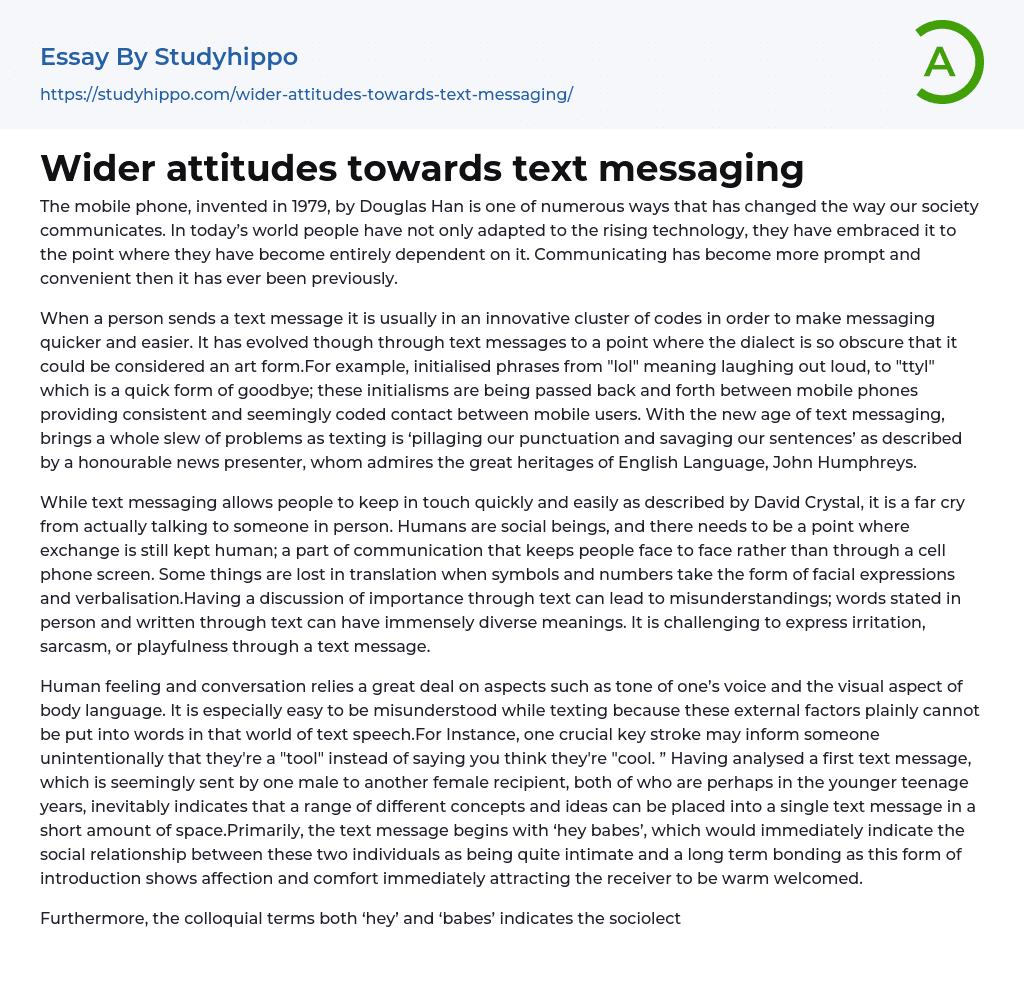The introduction of the mobile phone by Douglas Han in 1979 has revolutionized society's mode of communication. Today, people have not only adjusted to the advancement in technology, but have also adopted and relied heavily on it. The process of communication is now faster and more convenient than ever before.
Text messaging has evolved to create an innovative cluster of codes that aim to make messaging quicker and easier. This new dialect is so obscure that it has become an art form. Users exchange initialisms, such as "lol" for laughing out loud, or "ttyl" for goodbye, providing consistent and seemingly coded contact between mobile users. Unfortunately, this new age of text messaging also brings a whole slew of problems. Texting is pillaging our punctuation and savaging our sentences, as described by John Humphreys, a news presenter who admires the great heritage of the English lang
...uage.
According to David Crystal, text messaging is convenient for staying in touch but lacks the personal touch of face-to-face conversation. People need human interaction in communication, beyond screens on cell phones. Non-verbal cues and tone of voice are lost when exchanged through symbols and numbers in text messages. Misunderstandings can arise from trying to convey important messages through text, as words may have different meanings in writing than in speech. Expressing emotion, such as irritation, sarcasm, or playfulness, is difficult through text messages.
Human communication heavily relies on nonverbal cues such as tone of voice and body language. In the world of text messaging, these elements cannot be expressed, leading to potential misunderstandings. For example, a single keystroke can inadvertently convey the wrong message. An analysis of a text message sent from
male to a teenage female recipient illustrates the ability to convey various concepts and ideas with limited space. The message begins with "hey babes," indicating an intimate and established relationship between the two individuals. This friendly greeting reflects affection and fosters a warm reception from the receiver.
Moreover, the sender's use of colloquial terms like 'hey' and 'babes' suggests a low sociolect, possibly that of a young teenager. This informal texting helps to bridge barriers to convey a sense of care and happiness that might not be expressed face-to-face. The text message also features many logograms and contractions, such as 'u' for 'you', 'b' for 'be', 'sat' for 'Saturday', and 'shud' for 'should'. This conveys a sense of efficient texting, allowing the sender to quickly convey their excitement and urge to share news about the party with the recipient. The use of capitalization, repeated punctuation, and the repetition of the letter 'o' in 'soooo long!!!' suggest that it has been a lengthy period since their last interaction, with the repeated letter indicating an extended period, while the repeated punctuation helps to emphasize the extent of their break from communication.The writer demonstrates intelligence by using capital letters and bold typeface to convey emphasis without speaking. This indicates that texters are capable of representing visualizations that recipients can easily understand, even without face-to-face interaction, which aligns with David Crystal's views.
The following text message suggests a conversation between two educated adults who maintain proper English grammar, including capitalization and the correct usage of 'a' and 'an'. The lack of abbreviations in this message contradicts John Humphreys' belief that texting is erasing our language. The sender initiates the conversation with
a casual greeting using 'hey', a common practice among people of all ages during texting to create a sense of familiarity. The inclusion of a dash after 'hey' signals a shift in tone while maintaining grammatical structure. The usage of American slang 'freaked' signifies the sender's sociolect, an adaptation to foreign dialects, and displays an open expression of emotion towards the receiver, indicative of a strong relationship. Lastly, the sender employs logograms to conclude the message, expressing tender affection with 'xx'.Although the conversation could have included multiple 'x' letters to convey the same message had it been between teenagers, the use of only two demonstrates a sense of maturity and aging in the two participants. This highlights the capability of utilizing texting as a mature and efficient means of presenting ideas without the need for excessive time consumption. The and their content remain unchanged.
After examining how different age groups use text messages to express ideas, it's clear that both young and adult texters display intelligence and a polished manner through the ability to convey various tones and voice changes that aren't easily conveyed in standard English. However, texting can lead to some young people losing awareness of spelling and grammar, which then affects their ability to communicate in standard English. But, a study by David Crystal found that less than 10% of text messages contain abbreviations, suggesting that the stereotype of all texters using shorthand is incorrect. Incorrect spelling and contractions are actually indicative of a knowledge of correct spelling and the ability to form more efficient sentence codes. Interestingly, even the Victorians used "u" for "you," indicating that modern teenagers are following in
our ancestors' linguistic footsteps. Text messaging has both positively and negatively impacted society.
Despite being an effective method of message delivery, texting can impede our social interactions and potentially lead to a shift in our communication style.
- Attitude essays
- Goals essays
- Personal Goals essays
- Personal Life essays
- Personality essays
- Principles essays
- Reputation essays
- Self Awareness essays
- Self Esteem essays
- Self Reflection essays
- Self Reliance essays
- Strengths essays
- Value essays
- Values essays
- Weakness essays
- Who Am I essays
- Dialect essays
- English Language essays
- Second Language essays
- Semiotics essays
- Sign Language essays
- Spanish Language essays
- Artificial Intelligence essays
- Bitcoin essays
- Encryption essays
- Robotics essays
- Text Messaging essays




